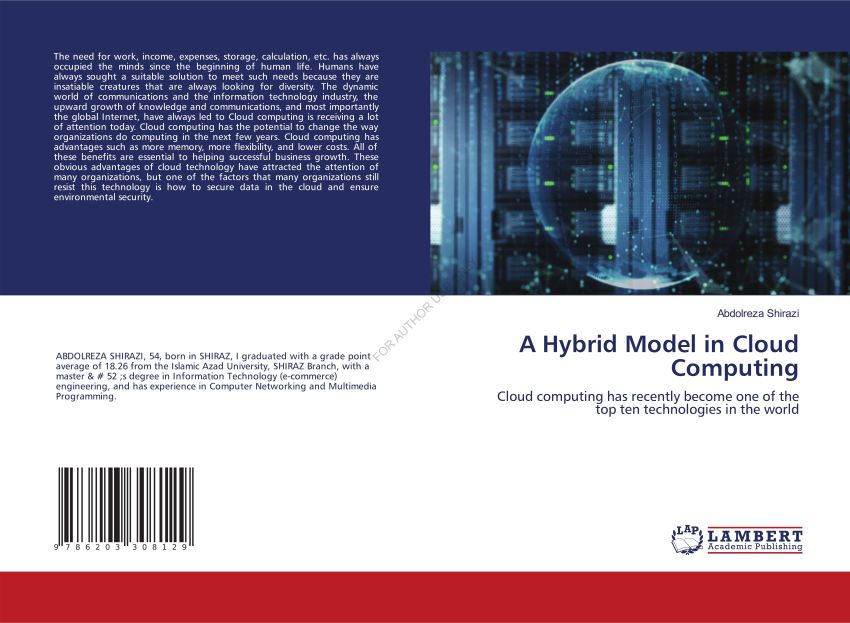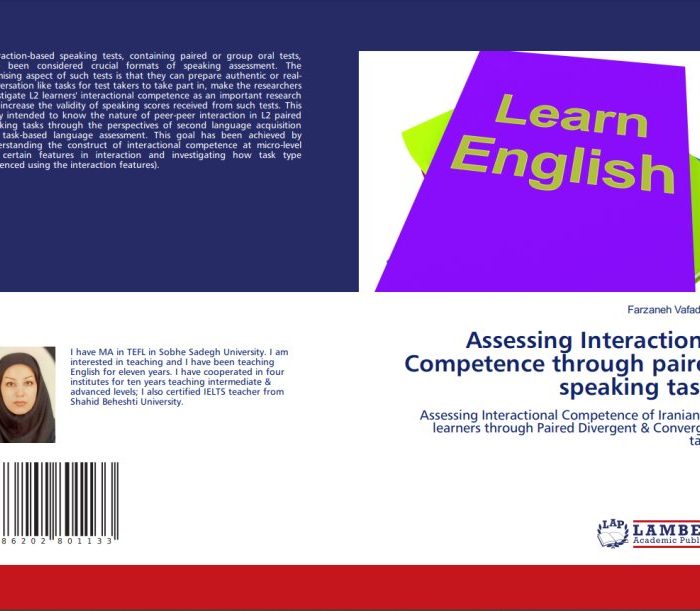کتاب A Hybrid Model in Cloud Computing
۳۱۵,۰۰۰ تومان قیمت اصلی: ۳۱۵,۰۰۰ تومان بود.۱۵۷,۵۰۰ تومانقیمت فعلی: ۱۵۷,۵۰۰ تومان.
| تعدادصفحات | 52 |
|---|---|
| شابک | 978-6203308129 |
| انتشارات |

در انبار موجود نمی باشد
کتاب A Hybrid Model in Cloud Computing – رویکردی نوین در محاسبات ابری
کتاب A Hybrid Model in Cloud Computing اثری جامع و پیشرفته است که به بررسی مدلهای ترکیبی در محاسبات ابری میپردازد. این کتاب چالشهای موجود در طراحی و اجرای سیستمهای ابری را تحلیل کرده و با ارائه رویکردهای ترکیبی، راهکارهایی برای بهبود کارایی، امنیت، و مقیاسپذیری پیشنهاد میدهد.
درباره کتاب A Hybrid Model in Cloud Computing
محاسبات ابری یکی از فناوریهای کلیدی در دنیای دیجیتال است که تحول عظیمی در مدیریت دادهها و ارائه خدمات ایجاد کرده است. در این کتاب، نویسنده با ارائه مدلی ترکیبی، مزایای استفاده از ترکیب زیرساختهای ابری عمومی و خصوصی را بررسی کرده و نشان میدهد که چگونه این رویکرد میتواند نیازهای متنوع سازمانها و کاربران را بهینهسازی کند.
موضوعات کلیدی کتاب
- مدلهای ابری ترکیبی: تحلیل ساختار و ویژگیهای مدلهای ترکیبی و مزایای آنها نسبت به مدلهای سنتی.
- چالشهای امنیتی و راهحلها: ارائه راهکارهای نوآورانه برای حفاظت از دادهها در محیطهای ابری ترکیبی.
- بهینهسازی هزینه و کارایی: بررسی نحوه کاهش هزینهها و افزایش بهرهوری در استفاده از مدلهای ترکیبی.
- مطالعات موردی: ارائه نمونههای عملی از سازمانهایی که از مدلهای ترکیبی در محاسبات ابری بهره بردهاند.
ویژگیهای برجسته کتاب A Hybrid Model in Cloud Computing
- تحلیل جامع و تخصصی: ارائه اطلاعات دقیق و بهروز درباره مفاهیم پیشرفته محاسبات ابری.
- رویکرد کاربردی: تمرکز بر چگونگی پیادهسازی مدلهای ترکیبی در محیطهای واقعی.
- ساختار منظم: ارائه مطالب با رویکردی سیستماتیک که درک مفاهیم را تسهیل میکند.
- منابع علمی معتبر: بهرهگیری از مطالعات و تحقیقات برجسته در زمینه فناوری اطلاعات.
چرا کتاب A Hybrid Model in Cloud Computing را بخوانید؟
این کتاب منبعی ارزشمند برای افرادی است که به دنبال درک عمیقتر از محاسبات ابری و نحوه استفاده بهینه از مدلهای ترکیبی هستند. با مطالعه این اثر، میتوانید دانش خود را در زمینه طراحی، مدیریت، و بهینهسازی سیستمهای ابری ارتقا دهید و با چالشهای مرتبط با این حوزه آشنا شوید.
مخاطبان کتاب A Hybrid Model in Cloud Computing
- دانشجویان و پژوهشگران فناوری اطلاعات: برای درک عمیقتر از مدلهای ترکیبی در محاسبات ابری.
- مدیران فناوری اطلاعات: برای بهبود تصمیمگیری در انتخاب و پیادهسازی زیرساختهای ابری.
- متخصصان و مهندسان سیستمهای ابری: برای ارتقای دانش فنی و توسعه راهکارهای نوین.
- علاقهمندان به تکنولوژیهای پیشرفته: برای آشنایی با کاربردهای واقعی و نوآوریهای محاسبات ابری.
سفارش کتاب A Hybrid Model in Cloud Computing
برای خرید این کتاب و دستیابی به اطلاعات تخصصی درباره مدلهای ترکیبی در محاسبات ابری، به بخش فروشگاه سایت مراجعه کنید یا با ما تماس بگیرید. این اثر راهنمایی برای کشف افقهای جدید در مدیریت دادهها و خدمات ابری است.
A Hybrid Model in Cloud Computing
Cloud computing has recently become one of the top ten technologies in the world
978-620-3-30812-9
1. کتاب “A Hybrid Model in Cloud Computing” درباره چه موضوعاتی صحبت میکند؟ ☁️
پاسخ: این کتاب به بررسی مدلهای ترکیبی در محاسبات ابری میپردازد و چالشهای امنیتی، اعتماد و نحوه مدیریت آنها در فضای ابری را تحلیل میکند. علاوه بر این، روشهای مختلف و ارزیابی آنها در زمینههای مختلف از جمله امنیت و مدیریت اعتماد در محاسبات ابری شرح داده شده است.
2. چالشهای امنیتی در محاسبات ابری چیستند؟ 🔒
پاسخ: محاسبات ابری با چالشهایی از قبیل دسترسی غیرمجاز به دادهها، حملات سایبری، حفاظت از دادهها در فضای عمومی و نیاز به اعتماد در تعاملات مختلف روبرو است. امنیت سختافزاری و نرمافزاری به عنوان دو بخش مهم از این چالشها مطرح هستند.
3. امنیت سخت و نرم در محاسبات ابری چه تفاوتی دارند؟ 🛡️
پاسخ: امنیت سخت به امنیت فیزیکی و شبکهای سیستمهای ابری اشاره دارد، مانند استفاده از فایروالها و رمزنگاری. اما امنیت نرم بیشتر به سیاستها، فرآیندها و نرمافزارهایی اشاره دارد که برای مدیریت خطرات و تهدیدات در محیط ابری طراحی میشوند.
4. مدیریت اعتماد در محاسبات ابری چه اهمیتی دارد؟ 🤝
پاسخ: مدیریت اعتماد در محاسبات ابری به معنای ارزیابی و تضمین قابل اعتماد بودن خدمات و منابع ابری است. استفاده از مدلهای اعتماد میتواند اطمینان حاصل کند که دادهها و منابع در یک محیط امن و قابل اعتماد مدیریت میشوند.
5. روشهای موجود در کتاب برای ارزیابی اعتماد در سیستمهای ابری کدامند؟ 📊
پاسخ: کتاب به توضیح روشهای مختلف برای ارزیابی اعتماد در سیستمهای ابری پرداخته است. این روشها شامل محاسبات اعتماد مستقیم و غیرمستقیم، و همچنین ارزیابی مجموع مقادیر اعتماد و تصمیمگیری بر اساس شرایط مختلف هستند.
6. مدل ترکیبی در محاسبات ابری چیست؟ ⚙️
پاسخ: مدل ترکیبی در محاسبات ابری به استفاده از ترکیبی از فناوریها و الگوریتمها برای حل مسائل پیچیده مانند مدیریت امنیت و اعتماد در فضای ابری اشاره دارد. این مدلها میتوانند شامل ترکیب روشهای مختلف محاسباتی برای بهبود کارایی و امنیت باشند.
7. در فصل سوم کتاب، چه موضوعاتی مورد بررسی قرار گرفته است؟ 📚
پاسخ: در فصل سوم کتاب، یک مرور ادبیات صورت گرفته و روش Somesh توضیح داده شده است. این فصل به بررسی روشهای مختلف در زمینه محاسبات ابری و مدلهای مدیریت اعتماد اختصاص دارد.
8. روش پیشنهادی در فصل چهارم چگونه کار میکند؟ 🔧
پاسخ: در فصل چهارم، یک روش جدید برای مدیریت اعتماد در محاسبات ابری ارائه شده است. این روش شامل فرآیندهای آغازین، تعامل با پایگاه دادهها، محاسبه اعتماد مستقیم و غیرمستقیم، و ارزیابی نهایی اعتماد بر اساس شرایط مختلف میباشد.
9. در فصل پنجم کتاب، روش پیشنهادی چگونه ارزیابی میشود؟ 🔍
پاسخ: در فصل پنجم، ارزیابی روش پیشنهادی با استفاده از معیارهای مختلف برای ارزیابی سیستمهای مدیریت اعتماد، شبیهسازی مدل پیشنهادی و تجزیه و تحلیل امنیت انجام میشود. نتایج شبیهسازی نشاندهنده اثربخشی روش در مدیریت اعتماد در محیطهای ابری است.
10. چه معیارهایی برای ارزیابی مدلهای اعتماد در محاسبات ابری وجود دارند؟ 📏
پاسخ: معیارهای ارزیابی مدلهای اعتماد شامل کارایی سیستم، دقت و سرعت ارزیابی اعتماد، امنیت دادهها و سازگاری با محیطهای مختلف ابری میشود. این معیارها به طور خاص در تحلیل شبیهسازیهای مدل پیشنهادی مورد بررسی قرار گرفتهاند.
11. نتایج شبیهسازی مدل پیشنهادی در کتاب چگونه ارزیابی شده است؟ 📈
پاسخ: نتایج شبیهسازی نشان میدهند که مدل پیشنهادی در زمینههای مختلف از جمله مدیریت اعتماد و امنیت، عملکرد بهتری نسبت به مدلهای دیگر ارائه شده دارد. شبیهسازیها با استفاده از دادههای محبوب در مدیریت اعتماد انجام شده است.
12. کتاب چه نتیجهگیریهایی درباره مدل ترکیبی در محاسبات ابری دارد؟ 💡
پاسخ: کتاب نتیجهگیری میکند که مدلهای ترکیبی میتوانند به طور مؤثری مسائل امنیتی و اعتماد را در محاسبات ابری حل کنند. این مدلها به بهبود کارایی سیستمها، افزایش امنیت و ارتقای سطح اعتماد در فضای ابری کمک میکنند.
این پرسشها و پاسخها میتوانند به شما در درک بهتر کتاب و مفاهیم مختلف آن کمک کنند. برای هر سوال، توضیحاتی که به کتاب و محتویات آن مرتبط هستند ارائه شده است.
| تعدادصفحات | 52 |
|---|---|
| شابک | 978-6203308129 |
| انتشارات |
محصولات مشابه
-
کتاب Assessing Interactional Competence through paired speaking tasks
۴۱۴,۰۰۰ تومانقیمت اصلی: ۴۱۴,۰۰۰ تومان بود.۱۷۹,۴۰۰ تومانقیمت فعلی: ۱۷۹,۴۰۰ تومان. -
کتاب Automated software debugging solutions
۳۱۵,۰۰۰ تومانقیمت اصلی: ۳۱۵,۰۰۰ تومان بود.۱۵۷,۵۰۰ تومانقیمت فعلی: ۱۵۷,۵۰۰ تومان. -
کتاب Determination of Changing Expression of miR-212 and EGFR Genes
۳۷۸,۰۰۰ تومانقیمت اصلی: ۳۷۸,۰۰۰ تومان بود.۱۶۳,۸۰۰ تومانقیمت فعلی: ۱۶۳,۸۰۰ تومان. -
کتاب Principles of crisis management: Principles of crisis management in the organization and individual life
۵۸۵,۰۰۰ تومانقیمت اصلی: ۵۸۵,۰۰۰ تومان بود.۱۹۵,۰۰۰ تومانقیمت فعلی: ۱۹۵,۰۰۰ تومان.












